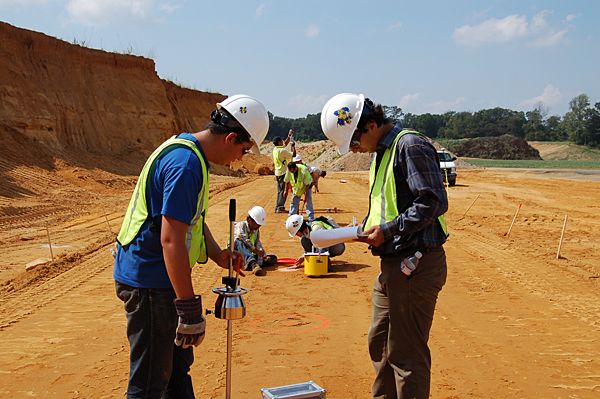The Important Payments of Geotechnical Designers in Assessing Soil Behavior and Foundation Style for Lasting Framework Growth
Geotechnical engineers serve as a foundation in the world of sustainable facilities development, where their knowledge in evaluating dirt actions straight affects the safety and security and longevity of structures. By utilizing innovative techniques such as Typical Penetration Examinations and Cone Infiltration Testing, they thoroughly review dirt residential properties, leading to educated decisions on foundation style.
Function of Geotechnical Engineers

Along with website investigations, geotechnical engineers examine prospective threats such as dirt liquefaction, slope stability, and groundwater issues. They use innovative design concepts to create remedies that minimize these dangers, making certain that styles abide by relevant codes and criteria. Their job commonly includes collaboration with various other engineering self-controls, architects, and ecological researchers to develop incorporated approaches to infrastructure advancement.
Furthermore, geotechnical designers add to lasting practices by promoting making use of products and approaches that lessen environmental impact. Via their detailed understanding of soil auto mechanics and geology, they play an essential duty in promoting secure, resistant, and lasting facilities that meets the demands of society while shielding the atmosphere.
Dirt Actions Evaluation Strategies
Recognizing dirt behavior is fundamental to informed decision-making in geotechnical engineering, as it directly influences the style and building and construction processes. Various assessment methods are used to evaluate dirt residential properties, ensuring accurate predictions of its efficiency under various loading problems.
One primary technique is the Basic Infiltration Test (SPT), which supplies insights into soil thickness and uniformity through the resistance experienced during penetration. Cone Infiltration Testing (CPT) provides a continuous profile of soil stratification and in-situ strength specifications, making it possible for a more detailed understanding of subsurface conditions.
Research laboratory tests, such as Atterberg restrictions, unconfined compressive stamina, and triaxial examinations, are vital for identifying dirt actions under regulated problems. These tests promote the determination of essential specifications, consisting of shear leaks in the structure, compressibility, and strength.

Structure Design Concepts
Structure design concepts are important for ensuring the security and longevity of structures, as they determine exactly how tons are sent from the superstructure to the underlying soil. These concepts encompass different considerations, consisting of load-bearing ability, negotiation, and side security. A thorough understanding of soil mechanics is vital for geotechnical designers to examine the communication in between the structure and the soil.
One trick concept is the ideal option of internet foundation type, which may consist of shallow foundations, such as spread footings, or deep structures, like piles or caissons, depending upon dirt problems and architectural lots - geotech engineer. The structure has to be designed to reduce visit differential settlement, which can lead to architectural damage

Sustainable Infrastructure Practices
Just how can we efficiently incorporate sustainability into facilities practices? Sustainable framework practices begin with thorough site evaluations, which evaluate dirt behavior, regional ecosystems, and resource schedule.
Moreover, utilizing cutting-edge construction methods, such as using recycled materials and low-impact structures, significantly lowers the carbon footprint of facilities projects. Geotechnical engineers play a pivotal function in picking ideal products that improve toughness and sustainability, such as utilizing geo-synthetics to improve dirt stability and lower erosion.
In enhancement, sustainable framework techniques need continuous monitoring and upkeep to make certain that structures continue to be durable over time. Eventually, these practices not just add to the durability of structures but also promote a healthier setting, lining up infrastructure advancement with broader sustainability purposes.
Study and Applications
Study in geotechnical engineering supply important understandings into the functional applications of soil habits and lasting infrastructure techniques. One significant instance is the building of the Burj Khalifa in Dubai, where extensive dirt screening and analysis were carried out to assess the one-of-a-kind difficulties postured by the region's loosened sand and high water table. Geotechnical engineers utilized progressed methods such as vibrant probing and cone infiltration testing to determine the dirt's load-bearing capability, inevitably causing the style of a deep structure system that sustains this legendary framework.
One more crucial case is the remediation of the San Francisco-Oakland Bay Bridge after the 1989 Loma Prieta earthquake. Geotechnical assessments revealed the requirement for dirt stablizing strategies, consisting of grouting and dirt nailing, to boost the seismic resilience of the foundation. These interventions not only enhanced the bridge's safety and security but likewise added to its longevity and sustainability.
Such case research studies exemplify how geotechnical engineers play an important role in understanding soil actions and applying ingenious solutions to guarantee the structural stability and sustainability of facilities jobs. geotechnical industry. Their expertise is important in dealing with the complex challenges posed by different dirt conditions throughout varied geographic places
Verdict
Finally, the contributions of geotechnical designers are crucial for the evaluation of soil habits and the layout of recommended you read foundations, which are vital for sustainable framework advancement. Through the application of innovative screening techniques and cutting-edge products, these specialists make sure the security and security of frameworks while lessening environmental influences. The integration of lasting methods advertises durability in infrastructure tasks, highlighting the value of collaboration amongst stakeholders to achieve reliable building and construction options that meet both social and environmental needs.
Geotechnical designers serve as a foundation in the world of sustainable facilities development, where their proficiency in analyzing soil habits straight influences the security and longevity of frameworks.Geotechnical designers play a crucial duty in the design and building and construction of infrastructure by analyzing dirt and rock habits to ensure security and security. An extensive understanding of soil technicians is crucial for geotechnical designers to assess the interaction between the dirt and the foundation.
Geotechnical analyses exposed the need for dirt stabilization methods, including grouting and soil nailing, to boost the seismic strength of the foundation.In final thought, the payments of geotechnical designers are essential for the assessment of dirt behavior and the style of structures, which are essential for sustainable facilities growth.
Comments on “A Complete Guide to Ending Up Being an Effective Geotech Engineer”